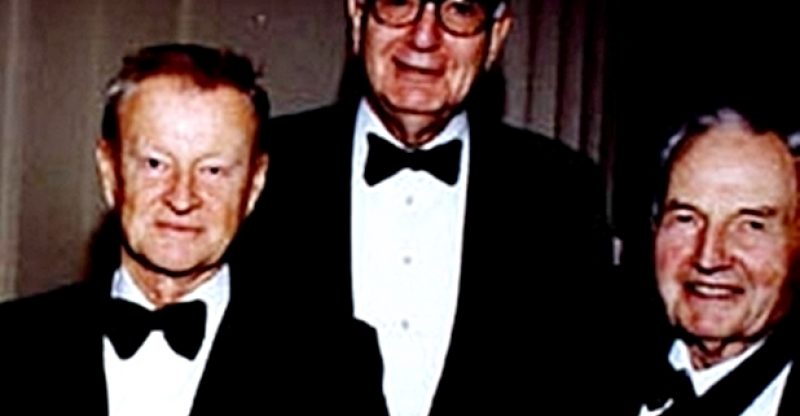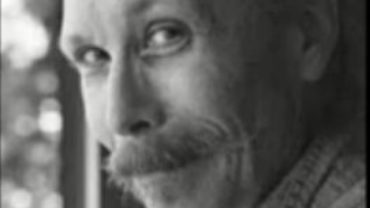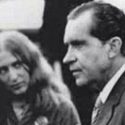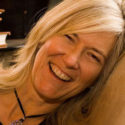Allegations regarding “Butch” Merritt, Watergate, Intelligence Agencies and “Crimson Rose,” Vol. XVIII
Endgame – Part Five
Written (and first posted) by Kris Millegan, April 8, 2011
If, after the inauguration, you find Cy Vance (former President of the Rockefeller Foundation) as Secretary of State and Zbigniew Brzezinski as head of National Security, then I would say we have failed. – Hamilton Jordan
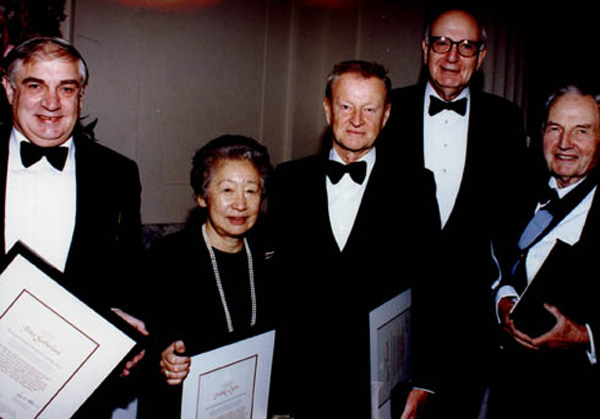
Peter Sutherland, Sadako Ogata, Zbigniew Brzezinski, Paul Volcker, David Rockefeller Anniversary Evening sponsored by the U.S. Group. December 1, 1998, New York City
Nelson didn’t make it to President – the “girls” didn’t perform well with guns. Oh, well, where there’s a will there’s a way, and without dropping a beat, the Rockefeller machine put in place a Democrat, taking the heat off the Republican scandals, letting a little water flow under the bridge and setting the stage for the final chapter of Watergate’s endgame. It would have been much simpler if Sarah or Squeaky had hit their marks, and Rocky had held the reins while slipping their empire agenda onto the taxpayer’s tab, but as has been said, “There is more than one way to skin a cat.”
Excerpts from two online essays about the Trilateral Commission (the idea introduced one month after the pivotal Watergate burglary):
The Trilateral Commission: World Shadow Government
The Trilateral Commission was established in 1973. Its founder and primary financial angel was international financier, David Rockefeller, longtime chairman of the Rockefeller family-controlled Chase Manhattan Bank.…Rockefeller’s idea for establishing the commission emerged after he had read a book entitled Between Two Ages written by an Establishment scholar, Prof. Zbigniew Brzezinski of Columbia University….
“Resist as it might,” Brzezinski wrote elsewhere, “the American system is compelled gradually to accommodate itself to this emerging international context, with the U.S. government called upon to negotiate, to guarantee, and, to some extent, to protect the various arrangements that have been contrived even by private business.”
Although the initial arrangements for the commission were laid out in a series of meetings held at the Rockefeller’s famous Pocantico Hills estate outside New York City, Rockefeller first introduced the idea of the commission at an annual meeting of the Bilderberg group, this one held in Knokke, Belgium in the spring of 1972.
David Rockefeller and Brzezinski then began the process of selecting from among the “Trilateral” nations the several hundred elite power brokers who would be permitted to join in Trilateral policy-making in the coming years.
One of the commission’s primary goals was to place a Trilateral-influenced president in the White House in 1976, and to achieve that goal it was necessary to groom an appropriate candidate who would be willing to cooperate with Trilateral aims.
Rockefeller and Brzezinski selected a handful of well-known liberal Democrats and a scattering of Republicans (primarily of the liberal-internationalist bent) to serve on the commission.
And in an effort to give regional balance to the commission Rockefeller invited the then-obscure one-term Democratic governor of Georgia, Jimmy Carter, to join the commission.
ROCKEFELLER CENTER SOUTH
Rockefeller had longtime ties to the local Atlanta political and economic Establishment. In fact, much of Rockefeller’s personal investment portfolio is in Atlanta real estate. (According to David Horowitz, co-author of The Rockefellers, “Atlanta is Rockefeller Center South.”)
And Rockefeller himself had once even invited Carter to dine with him at the Chase Manhattan Bank several years before, as early as 1971, the year Carter began serving as governor.
Carter very definitely impressed Rockefeller and Brzezinski, more so than another Southern Democrat, Florida Gov. Reuben Askew, also selected to serve on the commission and viewed, like Carter, as a possible Trilateral candidate.
In fact, according to Brzezinski,
“It was a close thing between Carter and Askew, but we were impressed that Carter had opened up trade offices for the state of Georgia in Brussels and Tokyo. That seemed to fit perfectly into the concept of the Trilateral.”
Carter, in fact, like Askew, did announce for the 1976 Democratic presidential nomination, but because of Rockefeller’s interest, Carter had the inside shot. So much so that in a speech at the commission’s first annual meeting in Kyoto, Japan in May of 1975, Rockefeller’s man Brzezinski promoted the then-still obscure Carter to his fellow Trilateralists as an ideal presidential candidate.
CUT AND DRIED
From that point on, it was all cut and dried. According to Goldwater:
“Rockefeller and Brzezinski found Carter to be their ideal candidate. They helped him win the Democratic nomination and the presidency.
“To accomplish this purpose they mobilized the money-power of the Wall Street bankers, the intellectual influence of the academic community — which is subservient to the wealth of the great tax-free foundations — and the media controllers represented in the membership of the CFR and the Trilateralists.”
The aforementioned Council on Foreign Relations — is another Rockefeller-financed foreign policy pressure group similar to the Trilateralists and the Bilderberg group, although the CFR is composed solely of American citizens.
In his book The Carter Presidency and Beyond, published in 1980 by the Ramparts Press, Prof. Laurence H. Shoup devotes an entire chapter to demonstrating how the Trilateral-linked and Trilateral-controlled Establishment media promoted the presidential candidacy in 1976 of the then-obscure Georgia Gov. Jimmy Carter. Carter, of course, campaigned as a “populist” — as a “man of the people” — as an “outsider” with no ties to the Establishment. The fact is, however, Carter, who said he’d never lie, was an elitist, an insider, the Trilateral Commission’s “man on the white horse.”
And with the power of the commission and the Rockefeller empire and its media influence behind him, Carter made his way to the presidency, establishing the first full-fledged Trilateral administration, appointing numerous Trilateralists to key policy-making positions and carrying out the Trilateral agenda to the hilt.
From The Modern History Project:
Late in 1972, W. Averell Harriman (known at that time as the “grand old man of the Democrats”), Establishment strategist and CFR member, told Milton Katz (also a CFR member and Director of International Studies at Harvard): “We’ve got to get off our high horses and look at some of those southern governors.” Carter was mentioned, and Katz informed Rockefeller, who had actually met with Carter in 1971, when they had lunch in the Chase Manhattan’s Board of Director’s dining room, and he was impressed with the fact that Carter had opened trade offices for the state of Georgia in Tokyo.
In February, 1973, while former Secretary of State Dean Rusk (a Bilderberger) was having dinner with Gerald Smith (U.S. Ambassador-at-Large for Non-Proliferation Matters), Rusk suggested that Carter would be a good candidate for the Commission. In April, while Robert Bowie (former professor of International Affairs at Harvard, who later became Deputy Director of the CIA), George S. Franklin (Rockefeller assistant, CFR member, and Coordinator for the Commission), and Smith were discussing the recruitment of candidates, it was decided that they needed better representation from the South. Franklin went to Atlanta to talk to Carter, and then proposed his name for membership. It had been a choice between Carter, and Gov. Reuben Askew of Florida.
In the fall of 1973, after having dinner with David Rockefeller in London, Carter’s political momentum began. From that point on, he was groomed for the Presidency by Zbigniew Brzezinski, and the Trilateralists. Just to be on the safe side, they also brought in Minnesota Senator Walter Mondale (a protege of Hubert Humphrey, whose eventual withdrawal from the Presidential race guaranteed the Democratic nomination for Carter), and Rep. Elliot Richardson (former U.S. Attorney General; Secretary of Health, Education, and Welfare and Secretary of Defense, and Under Secretary of State under Nixon; former Secretary of Commerce under Ford; and former Ambassador to Great Britain) as possible candidates, and even considered Sen. Ted Kennedy of Massachusetts.
Brzezinski said in an October, 1973 speech: “The Democratic candidate will have to emphasize work, family, religion, and increasingly, patriotism, if he has any desire to be elected.” Carter campaigned by stressing those very virtues, as he asked America to elect him, an “outsider,” to clean up the mess in Washington.
In December, 1975, seven months before the Democratic National Convention, the Gallup Poll indicated that only 4% of the country’s Democrats wanted Carter. Even the Atlantic Constitution in his own state, ran a headline which said: “Jimmy Carter Running For What?”. However, within six months the nomination was his because of the most elaborate media campaign in history. Carter was glorified as the new hope of America as the media misrepresented his record as Governor in Georgia. This led former Georgia Governor Lester Maddox to say: “Based on false, misleading and deceiving statements and actions … Jimmy Carter in my opinion, neither deserves or should expect one vote from the American people.”
Even though Carter later resigned from the Trilateral Commission, he was hardly an “outsider.” He was supported by the Trilateral Commission, the Rockefellers, and Time magazine. Early contributions came from Dean Rusk, C. Douglas Dillon, Henry Luce, and Cyrus Eaton. Leonard Woodcock of the United Auto Workers Union, and Henry Ford II, both of whom are CFR members, endorsed Carter on the same day.
Carter’s two major foreign policy speeches during the primary campaign were made to the Chicago Council on Foreign Relations and the Foreign Policy Association. He used terms like “a just and peaceful world order,” and “a new international order.” In another primary campaign speech, Carter talked about “world-order politics.”
A Los Angeles Times article in June, 1976, identified the advisors that helped Carter prepare his first major speech on foreign policy, all of whom were all members of the CFR and most were also members of the Trilateral Commission:
- Zbigniew Brzezinski
- Richard Cooper
- Richard Gardner
- Henry Owen
- Edwin O. Reischauer
- Averell Harriman
- Anthony Lake
- Robert Bowie
- Milton Katz
- Abram Chayes
- George Ball
- Cyrus Vance
After Carter beat Gerald Ford, Hamilton Jordan, his chief aide, said: “If, after the inauguration, you find Cy Vance (former President of the Rockefeller Foundation) as Secretary of State and Zbigniew Brzezinski as head of National Security, then I would say we have failed.” In an interview with Playboy magazine, Jordan said he would quit if they were appointed. They were; he didn’t.
Brzezinski, whom Henry Kissinger had called his “distinguished presumptive successor”, had become Carter’s biggest influence.
The Commission, which operates in literal secrecy, made news in the fall of 1979, when David Rockefeller, Henry Kissinger, and John J. McCloy (former President of the Ford Foundation, former President of the World Bank, Chairman of the Chase Manhattan Bank, former High Commissioner to Germany, and on the Advisory Board of Foreign Affairs magazine) pressured Carter into allowing the deposed Shah of Iran (who had financial dealings with the Chase Manhattan) into the country for medical treatment. The move caused the Iranian government, under the leadership of the Ayatollah Khomeini, to storm the American Embassy, and hold 52 American hostages for nearly 1-1/2 years. Carter’s inadequacy in dealing with this situation certainly cost him the election
Before Carter could be placed in power, something needed to be done about all the allegations about the CIA and other spy agencies. First there is the “Rockefeller Commission”:
An important article that help us understand is the January 20, 1975, New York magazine article by Tad Szulc, “How Nixon Used the CIA”:
President Ford no sooner said that he wished to know and tell the whole truth about the illegal domestic operations of the Central Intelligence Agency than he placed this investigation in the hands of an eight-man blue-ribbon commission whose immediate problem may lie in its own unreality. Its chairman, Vice-President Nelson Rockefeller, and several of its most knowledgeable members have long, intimate, and protective ties with the U.S. intelligence community, which could conceivably lead them to see the C.I.A.’s controversial doings in a relatively charitable light.
The crucial question to be answered by the commission is this: who knew about the C.I.A.’s portion of what John Mitchell characterized as the Nixon White House “horrors”? Was it Richard Nixon himself, orchestrating a comprehensive plan to push the United States toward a police state? Was it former C.I.A. Director Richard Helms? Was it General Robert Cushman Jr., a close associate of Richard Nixon’s and, at the time, the agency’s deputy director? Or was it Secretary of State Henry Kissinger, the man who, in effect, runs the entire U.S. intelligence community? Charity may not be the most necessary attribute for a group whose mission includes determining whether sufficient safeguards surround the C.I.A.
In any event, this commission can hardly do its work adequately unless, along with the Watergate, special prosecutor, it gains access to the treasure trove of Richard Nixon’s materials held back by the Ford White House because of Nixon’s own legal challenges.
Federal investigators are convinced that among the 900 reels of tapes (adding up to some 5,400 listening hours) and 42 million documents in the White House complex there is ample evidence to verify how and why the former president and his associates went about misusing and abusing the American intelligence community for their own political ends – at the expense of the civil rights of American citizens.
The C.I.A. and military intelligence have been snooping around the United States for a long time, but there has been nothing quite like the carryings on under Nixon. These activities far transcend in importance recently reported “massive” C.I.A. spying on antiwar militants, if it really occurred. They included direct domestic police functions in support of local police forces, White House-directed surveillance of selected individuals for political reasons, considerable cooperation with the “plumbers,” and the management of a S200-million-a-year top-secret C.I.A. corporate empire. [emphasis added]
The existence of this vast international corporate empire has a new relevance, presumably of interest to the Rockefeller commission. Present foreign aid legislation prohibits …the funding of covert C.I.A. operations abroad unless the president certifies to Congress their need for U.S. national security. The availability of funds in C.I.A.-owned and profit-making businesses could circumvent the intent of Congress. [emphasis added]
New York Magazine has learned details of these and other hidden intelligence operations through recent research and wide-ranging interviews throughout the United States intelligence community. A presidential commission seriously interested in getting to the bottom of things surely could do much more. Curiously, though, the contents of the Nixon cache, which would be the most vital aspect of its investigations, were referred to by neither Ford nor any other senior administration official in the course of announcing formation of the commission. The commission’s present plan is to interview C.I.A. Director William Colby as its first witness, then move on to Kissinger and others. The Nixon tapes would speak for themselves. The C.I.A. will tell as much, or as little, as it chooses to the blue-ribbon investigators, a potentially sympathetic group. The chairman, Rockefeller, served on the Foreign Intelligence Advisory Board, theoretically a supervisory group for U.S. intelligence-gathering activities, from 1969 to 1974. Its membership includes such old friends of the C.I.A. as former Treasury Secretary C. Douglas Dillon, former California Governor Ronald Reagan, and former Chairman of the Joint Chiefs of Staff General Lyman Lemnitzer. As J .C.S. chairman, General Lemnitzer was on the White House’s “303 Committee” – now known as the “40 Committee” – which supervises the most secret United States foreign covert intelligence operations.
The A.F.L.-C.I.O. whose secretary-treasurer, Lane Kirkland, is on the panel, provided in the sixties an umbrella for C.I.A. activities in Latin America by setting up the American Institute for Free Labor Development. Kirkland is also a member of Rockefeller’s earlier commission on “critical choices.”
Nixon’s legal suits to prevent access to his tapes and documents constitute a legal cover-up. It is aimed at voiding an agreement signed last November between the Ford White House and the special prosecutor to make the pertinent files available for the preparation of additional Watergate indictments.
Inasmuch as one of Nixon’s suits challenges the constitutionality of a recent congressional act which ratifies, in effect, the Ford-special prosecutor agreement, the case may go all the way to the Supreme Court, indefinitely delaying all the investigations. The blue-ribbon commission must report by April 4 (even though it is unlikely that litigation over Nixon’s materials will be resolved by then).
The White House tapes and documents are also believed to contain juicy material that would document other areas of Nixon abuses – most notably concerning illegal wiretaps, violations of the Internal Revenue Service’s statutes on the secrecy of tax returns, and other startling attempts to subvert the functions of government departments for the former president’s political advantage.
If the tapes are obtained, the special prosecutor hopes later this year to come up with new indictments against, among others, those who during Nixon’s reign installed what are believed to have been illegal national security wiretaps against administration officials and Washington newsmen. Federal Bureau of Investigation agents, Justice Department Internal Security Division officials, Washington police officers, or even C.I.A. operatives may have done the work. Should the wiretap case go to trial, the special prosecutor is certain to call as witnesses Kissinger and his former deputy, General Alexander M. Haig Jr., who is now commander-in-chief of NATO forces. Both have already acknowledged recommending the names of those to be wiretapped.
The Nixon tapes might also explain why the Nixon administration late in 1972 created a mysterious military intelligence office known as Defense Investigative Service (D.I.S.) located in the Forrestal Building in downtown Washington. The D.I.S., reportedly staffed by a number of ex-C.I.A. agents from domestic intelligence units, reports directly to the Office of the Secretary of Defense, significantly by-passing the Defense Intelligence Agency. [emphasis added]
Inquirers at the Pentagon about the D.I.S. are told that this office centralizes security clearance for defense contractors. But there is doubt that this is its only function. Until his retirement late in 1974, the D.I.S. was headed by Air Force Brigadier General Joseph Cappucci, formerly chief of the air force’s Office of Special Investigation. Insiders say that clearing defense contractors would hardly be a task given a senior military intelligence officer. Political intelligence within the air force was a responsibility of the Office of Special Investigations.
Officials familiar with the situation suggest that new disclosures from the Nixon materials may create acute embarrassment for Henry Kissinger. Inasmuch as the C.I.A. reports to the president of the United States through the mechanism of the National Security Council, headed by Kissinger since 1969, and since he is chairman of the N.S.C.’s “40 Committee,” concerned with the most secret intelligence operations abroad, it is a valid question how much he might have known about the agency’s secret operations.
Privately, many officials further argue that Kissinger probably had to be aware of the C.I.A.’s domestic activities. For example, the dividing line between the agency’s foreign and domestic counterintelligence work – the tracking of foreign intelligence operatives – is completely blurred, particularly since J. Edgar Hoover, the Federal Bureau of Investigation’s late director, suspended all counterespionage cooperation with the C.I.A. in 1969. If indeed other C.I.A. units aside from the Counterintelligence Staff belonging to the office of the Deputy Director of Operations (D.D.O.), also known as the Clandestine Services, became engaged in purely domestic operations between 1969 and 1972, it would have been an affront to Kissinger to keep him in the dark. It must be remembered that from the moment he moved into the White House, in 1969, Kissinger insisted on maintaining full control of the C.I.A. to the point where successive C.I.A. directors had no direct private access to Nixon; the present director, William E. Colby, usually sees President Ford in Kissinger’s presence. [emphasis added]
After Ford requested a report from Colby on the C.I.A.’s illegal activities following publication in The New York Times on December 22 of the “massive spying” charges, it was Kissinger, as the head of the N.S.C. mechanism, who was instructed to transmit Colby’s response to the president. In this sense then, Kissinger is part and parcel of the whole intelligence controversy. As of now, so is his friend and benefactor, Vice-President Rockefeller.
There are also some reasons to suspect that the whole affair is immensely more complex and sensitive than the simple possibility that the Counterintelligence Staff ran private spying operations against the antiwar movement. There have been a number of unexplained moves both by the C.I.A. and the White House suggestive of a no-holds-barred power struggle within the intelligence community, possibly involving Kissinger himself. Ford’s decision to “get to the bottom” of the present C.I.A. affair – an “abrupt” departure from past White House practice in C.I.A. matters – is an eIement in the mystery. [emphasis added]
One possibility, insiders say, is that the need was perceived at the highest levels of the government to hide the real C.I.A. enterprises during the Watergate era – such as undertaking direct police functions and dirty work for the Nixon White House. Because bits of information were beginning to surface, these insiders say, it was judged less damaging to go along with the limited charge of “massive spying” against the antiwar movement.
A related possibility is that the “massive spying” disclosures last month were the result of deliberate C.I.A. leaks. Their objective: to help eliminate James Angleton, the head of the Counterintelligence Staff, one of the C.I.A.’s most powerful and independent senior officials and long a thorn in Colby’s and Kissinger’s sides. [emphasis added]
Angleton and his Counterintelligence group were initially singled out as culprits in the spying scandal despite the high probability, as it now appears, that an entirely separate C.I.A. branch, the Domestic Operations Division, conducted domestic operations.
Published reports early this month indicated that both Colby and Kissinger resented Angleton’s personal control of all intelligence liaison with Israel. Unlike all other cases involving foreign intelligence, the C.I.A.’s relations with Israel were handled by Counterintelligence rather than a geographic division of Clandestine Services.
Some knowledgeable State Department officials say that Kissinger felt that Angleton’s operations interfered with his Middle East diplomacy. Counterintelligence was apparently the only area in the C.I.A. that resisted Kissinger’s sway. In addition, Angleton was known to hold a low opinion of the detente engineered and negotiated by Kissinger with the Soviet Union. [emphasis added]
Angleton himself told newsmen that Colby had asked him to resign in the wake of the domestic spying charges (although he was to remain with the agency as “a consultant” while the Counterintelligence Staff is being reorganized and a new chief named). Three of Angleton’s deputies were also asked to resign. But New York Magazine has learned that Colby actually moved to fire him two or three days before The Times published its report on domestic spying naming Angleton as the man responsible. [emphasis added]
If this theory is correct, we may be facing an extraordinary combination of a cover-up of the C.I.A.’s domestic activities on Nixon’s behalf with esoteric intrigues within the agency itself – indeed, within the entire American intelligence community – a combination that cannot help but affect the conduct of American foreign policy.
The very structure of the agency’s “Clandestine Services,” the secretive Directorate of Operations (see table on page 33), helps explain how such things are possible. So that perfect security and secrecy may be assured, the agency frequently insists on the right hand’s not knowing what the left hand does – the principle of ” compartmentalization.” In all D.D.O. operations, knowledge is confined to those with “the need to know” – and it can’t even be ruled out that in some cases the C.I.A. director himself may have looked the other way on the theory, as a C.I.A. veteran put it, that “what you don’t know don’t hurt you.”
During the Nixon period – until his removal early in 1973 – the C.I.A. director was Richard Helms, a lifelong clandestine operator. His deputy director of Central Intelligence (D.D.C.I.) was Lieutenant General Robert Cushman, once Nixon’s military assistant and now commandant of the marine corps. Helms and Cushman were supported by four C.I.A. deputy directors, one of whom was the deputy director for plans (recently the title was changed to deputy director of operations).
This post was held until early 1973 by Thomas Karamessines. He and his deputy, Cord Meyer Jr., were in charge of all clandestine operations. The directorate was divided into four main branches reporting directly to Karamessines. (A fifth branch, the Science and Technology Office, was subsequently added.) For specific operational purposes, however, Karamessines also ran two parallel groups of divisions, one foreign and one domestic. These were hierarchically separated from the special staffs such as Counterintelligence- or Covert Action. Six regional divisions supported by subregional and country desks formed the geographic group and worked with the special staffs on specific overseas operations. [emphasis added]
On the domestic side, the directorate had – and still has – four divisions. In varying degrees, they were all involved in Nixon-era secret domestic operations.
The little-known Domestic Operations Division (D.O.D.) and the mysteriously named “Division D” (now renamed “D Staff”) carried out the bulk of domestic activities, ranging from wholly legitimate ones to some that were quite shady. They were logistically aided, as the rest of the C.I.A. is, by the specialized Technical Services Division (T.S.D.) and Records Integration Division (R.I.D.).
The Domestic Operations Division is in charge of a network of C.I.A. offices located in at least fifteen American cities. Some of these offices are overt and even listed in local telephone directories (under “Central Intelligence Agency”). The division’s so-called “00” offices, for example, concentrate on debriefing American travelers returning home from trips to countries in which the C.I.A. has a special interest. Inasmuch as the Counterintelligence Staff worries about foreign agents, such as Soviet K.G .B. operatives, entering the United States, it may occasionally request the D.O.D. to lend a hand in tracking them. Such interceptions were once made by the F.B.I., but when Hoover gave up his counterespionage functions, this follow-up was made by C.I.A. Counterintelligence or the D.OD.
That which C.I.A. officials speaking privately have conceded to be the “gray area” of operations is the surveillance of American citizens suspected of contacts with foreign intelligence. Although the 1947 National Security Act, which created the C.I.A., specifically forbids domestic police functions by the agency, it is argued that such activity is simply an extension of foreign counterintelligence.
It is widely known in Washington intelligence circles that the C.I.A., and especially Counterintelligence, suspected a number of dissident and radical American groups of ties with Communist intelligence services – and not only in the antiwar movement context. The Black Panthers, for example, were under close C.I.A. surveillance based on the suspicion – never proved – that many of its members traveled to Algeria and Moscow for ideological indoctrination and then to North Korea for sabotage and guerrilla training. Similar suspicions surrounded young Americans who had visited Cuba.
The C.I.A. increased this surveillance under Nixon even though the National Advisory Commission on Civil Disorders, formed by former President Johnson, had concluded that there was no foreign subversive conspiracy behind racial riots. The C.I.A. had worked closely with the commission. Cord Meyer, the Clandestine Services’ deputy chief, was the agency’s liaison official.
But although it engaged in financing such groups as the National Student Association for intelligence operations abroad, and publishing houses, magazines, and news agencies for foreign propaganda in pre-Nixon days, former Director Richard Helms and the C.I.A. drew a line at “targeting” Americans at home. Nor would the C.I.A. busy itself abroad on essentially domestic matters. In the 1960’s, for example, Helms personally refused a request from the Internal Revenue to establish surveillance in South America on a tax evader, an American citizen, who had skipped overseas owing hundreds of thousands of dollars in back taxes.
Under Nixon, however, the climate changed totally. In December 1970, Helms fitted the C.I.A. into the secret Intelligence Evaluation Committee at the White House. The unit grew out of the secret domestic intelligence plan drafted for Nixon by his aide Tom Huston six months earlier. Under enormous White House pressure, the C.I.A. began to become involved in domestic activities, often in clear violation of its own statute. [emphasis added] For example:
1. Police functions. During the 1969-1972 period of massive antiwar demonstrations, particularly in Washington, the C.I.A., responding to White House requests, trained and advised local police departments in the arts of intelligence and communications. The C.I.A.’s Domestic Operations Division, the Technical Services Division, the Records Integration Division, and the “D Staff” were all involved. The “D Staff” was in charge of communications and intelligence collection for local police forces. This presumably included direct surveillance of Americans. but as an ancillary rather than principal function. The R.I.D. helped out with computer read-outs from files kept by the C.I.A.’s Counterintelligence, the F.B.I. (which did work on domestic riot control), and the military intelligence services. The Technical Services provided highly sophisticated equipment, such as devices showing whether a person had held metal – a gun – in his or her hand hours earlier.
The C.I.A. doesn’t actually deny its training and equipment support for the Metropolitan Police Department in Washington. The C.I.A. claims, perhaps lamely, that it had acted in the belief that it was meeting the requirements of the 1968 Omnibus Crime Control and Safe Streets Act. [emphasis added]
There is no question but that this C.I.A. police function, also carried out in New York and Chicago, specifically violated the National Security Act. C.I.A. training of U.S. police forces ended early in 1973, after a New York Times article alluded, in general terms, to such assistance.
2. Plumbers. The record of Watergate investigations shows that acting on a telephone call from John Ehrlichman, then Nixon’s chief of the Domestic Council, the C.I.A. provided one of the plumbers, Howard Hunt, with disguise equipment on a “one-time basis.” This was authorized by General Cushman, then the C.I.A.’s deputy director, and the material was provided by the Technical Services Division.
But private investigations suggest that in addition to the help obtained from the C.I.A. headquarters on this particular occasion, the plumbers were equipped for other missions by the agency’s clandestine offices in Miami and outside San Francisco. The so-called “green light” group in the C.I.A.’s Miami office reportedly provided Hunt with some of the equipment for the June, 1972, Watergate break-in. The C.I.A. office in Burlingame, near San Francisco, apparently did likewise in connection with the plumbers’ break-in, in 1971, into Daniel Ellsberg’s psychiatrist’s offices. In 1973, when investigations uncovered the agency’s role in equipping Hunt, a senior officer of the Technical Services Division, Howard Osborne, was quietly fired from the C.I.A.
In Las Vegas, Nevada, where the plumbers had planned an operation against newspaper publisher Hank Greenspun , the C.I.A. maintains one of its largest domestic clandestine offices, run by, the D.O.D. It remains unclear why Las Vegas, hardly an espionage center, rates a big C.I.A. station. [emphasis added]
3. The corporate empire. This is one of the C.I.A.’s most sensitive secrets. The network of C.I.A.-owned companies was created in 1950, at the height of the Cold War, to provide fireproof covers for overseas operations. In the 1960’s, it was used to disguise the financing of such enterprises as the Bay of Pigs invasion of Cuba, the use of anti-Castro Cuban pilots and B-26’s in the Congo, the “secret army” of Meo tribesmen in Laos, and a variety of other covert activities. Under Nixon, funds for domestic operations, including some plumber-type operations, were channeled through the C.I.A.’s “proprietary” or front corporations. The most famous, though not necessarily the most important, of them was the Robert R. Mullen & Co. in Washington, where Hunt was “employed” after leaving the C.I.A. [emphasis added]
The holding company for the C.I.A.’s corporate empire is the Pacific Corporation located in Washington. Pacific, whose subsidiaries are said to employ some 20,000 people worldwide, was incorporated in Dover, Delaware, on July 10, 1950, by the Prentice Hall Corporation (no kin to the publishing firm of that name), an incorporating agent for hundreds of firms that enjoy Delaware’s tax advantages. A C.I.A. official familiar with the Pacific Corporation explained that in this and every other case where a C.I.A. company is incorporated in a state capital, the local secretary of state is informed of the true nature of the enterprise to avoid tax or any other inquiries. Thus Delaware’s secretary of state refuses to disclose the names of Pacific’s directors at the time of the incorporation.
The Pacific Corporation owns such operational C.I.A. companies as Air America, Inc., whose planes supported all the agency operations in Indochina; C.A.T. (Civil Air Transport) Co., Ltd., a Taiwan-based airline often used by the C.I.A.; Air Asia Co., Ltd., specializing in aircraft maintenance; the Pacific Engineering Company; and the Thai Pacific Services Co., Ltd .
The Pacific Corporation and these five other companies have headquarters in a third-floor suite at 1725 K Street, Northwest, in Washington. Oddly, all six are listed in the building directory and in the Washington telephone book. But to a casual visitor to the K Street building lobby, all these names are wholly meaningless, as are those of nine officials listed under Suite 309. Curiously, however, the name of Hugh L. Grundy, who is president of the Pacific Corporation, Air America, and Air Asia, is not listed anywhere.
C.I.A. insiders say that the Pacific Corporation may own dozens of other companies elsewhere in the United States and abroad. It may be impossible to unravel all the corporate ramifications of the Pacific firm without a detailed inspection of the C.I.A.’s books, something a determined presidential commission could do.
It is known that the Pacific Corporation had about $200 million in” sales” in 1972. This fact emerged when the Price Commission, engaged in classifying companies by their size for reporting purposes, came upon the Pacific Corporation’s tax returns.
Tax returns? Of course. Because the corporation serves as a C.I.A. cover, it has to behave like all other companies. Thus it pays taxes. The C.I.A. realized, however, that the Pacific Corporation’s cover was in jeopardy if the Price Commission applied to it the rule that all companies with sales in excess of $50 million annually must report their activities. Accordingly, the Pacific Corporation sent a letter to the Price Commission advising it that its domestic sales were below $50 million – that the balance was in foreign operations.
Break-ins into foreign embassies and United Nations missions are justified on counterintelligence grounds. (On one occasion C.I.A. raiders found $300,000 in purloined stock certificates instead of diplomatic codes in the safe of a Latin American diplomat in New York; they left the certificates in the safe and fled.) The same explanation applies to one or two break-ins into the homes of C.I.A. officials suspected of leaks or other ties with foreign intelligence services.
As we have seen, one hand at the C.I.A. often doesn’t know what the other does. This surely applied during the Nixon period, when the White House may have been dealing directly with senior C.I.A. officials friendly to it and willing to twist the statute to please the president. But at this point in time, as they say, the C.I.A. looks very much like a public agency of awesome power that is now beyond effective public control. And there is reason to wonder whether the Rockefeller commission may be up to the job of checking it and providing the safeguards promised by President Ford.
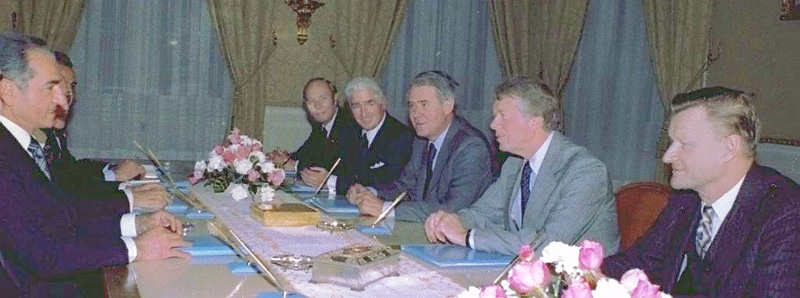
to be continued…
Watergate Exposed: How the President of the United States and the Watergate Burglars Were Set Up (as told to Douglas Caddy, original attorney for the Watergate Seven), by Robert Merritt is available at TrineDay, Amazon, Barnes & Noble, The Book Depository, and Books-a-Million.





